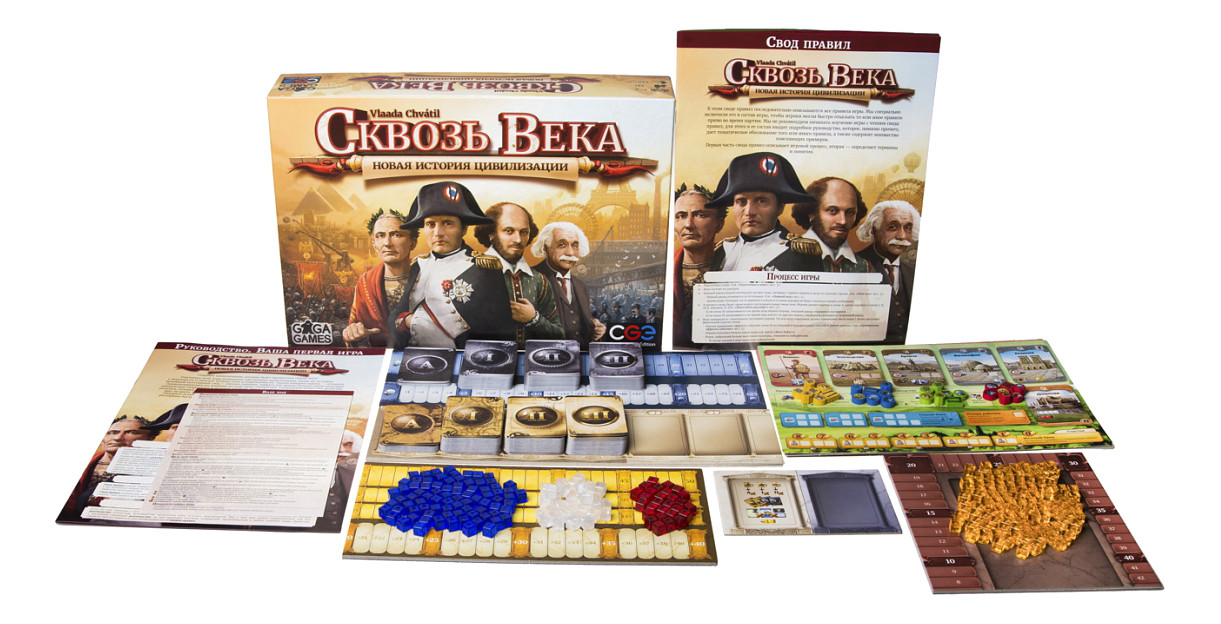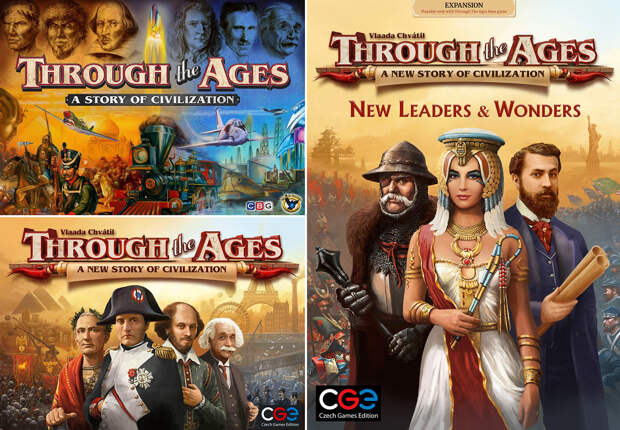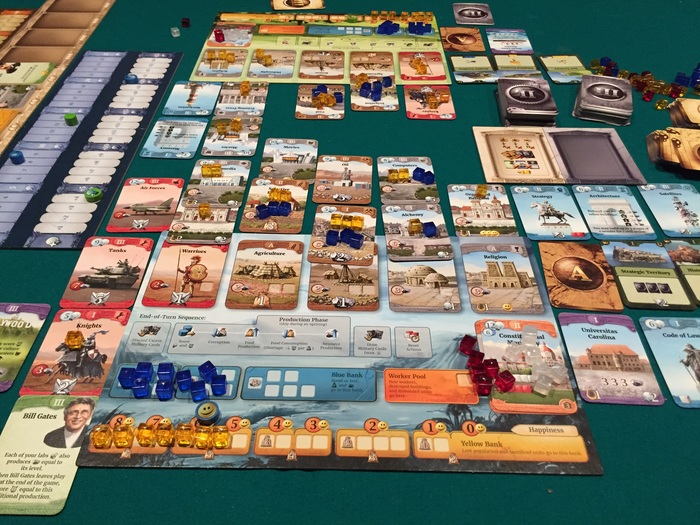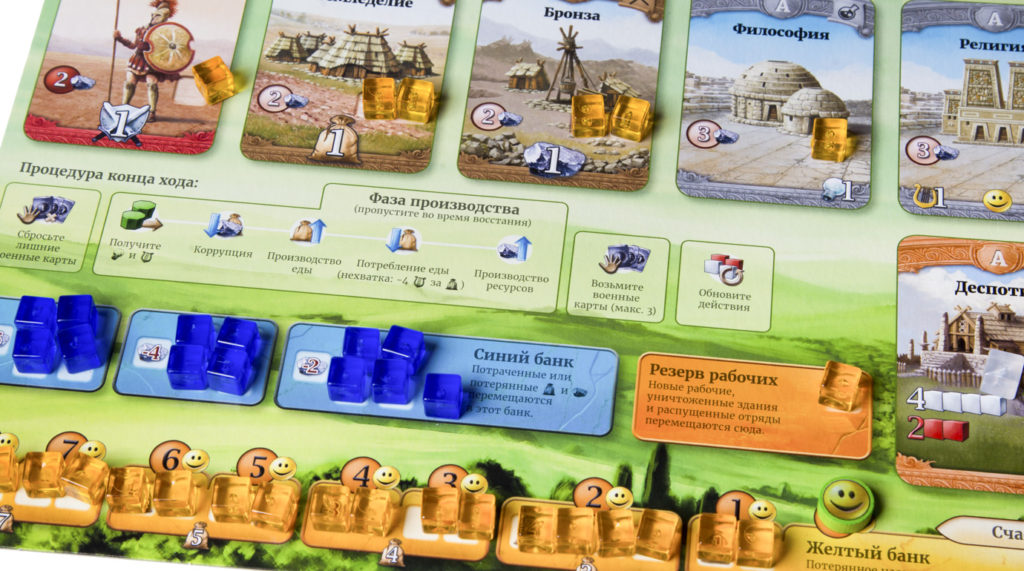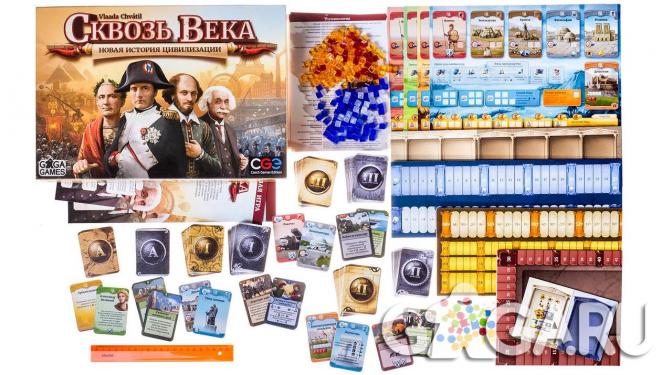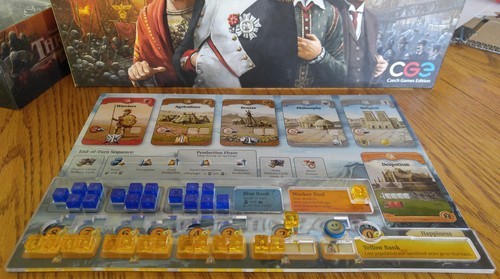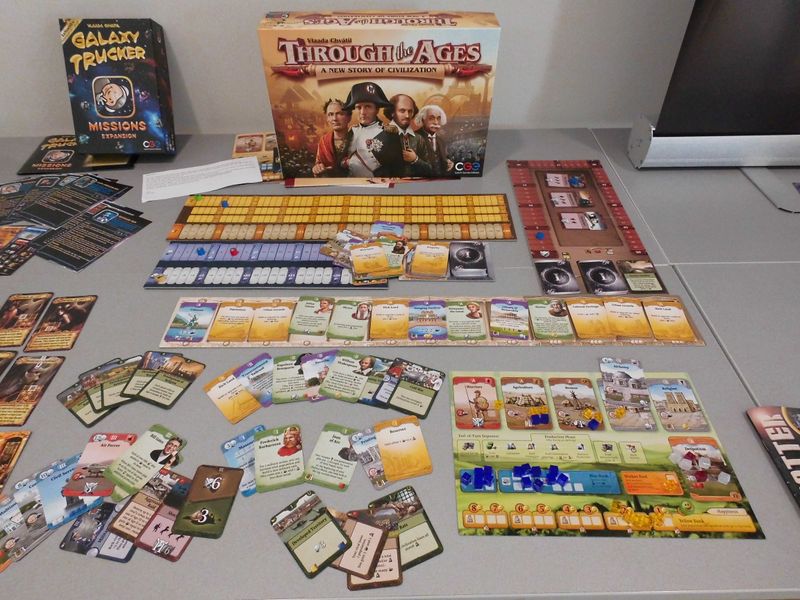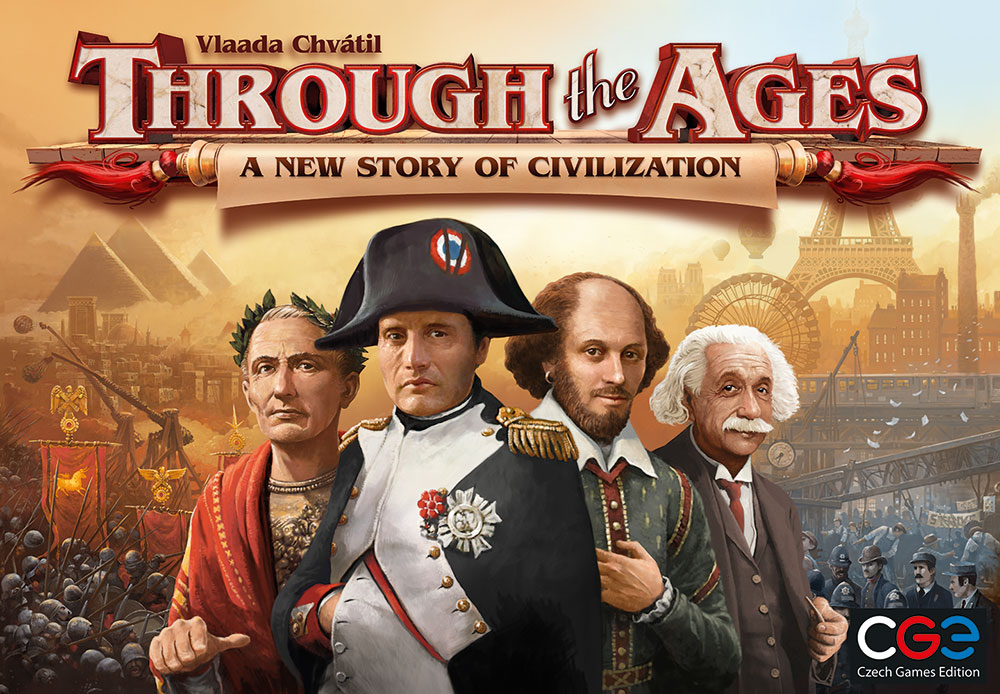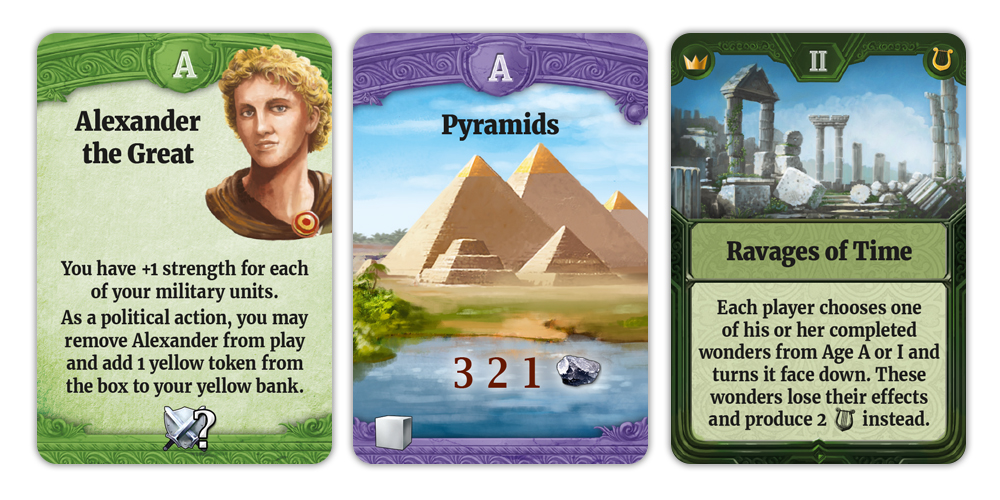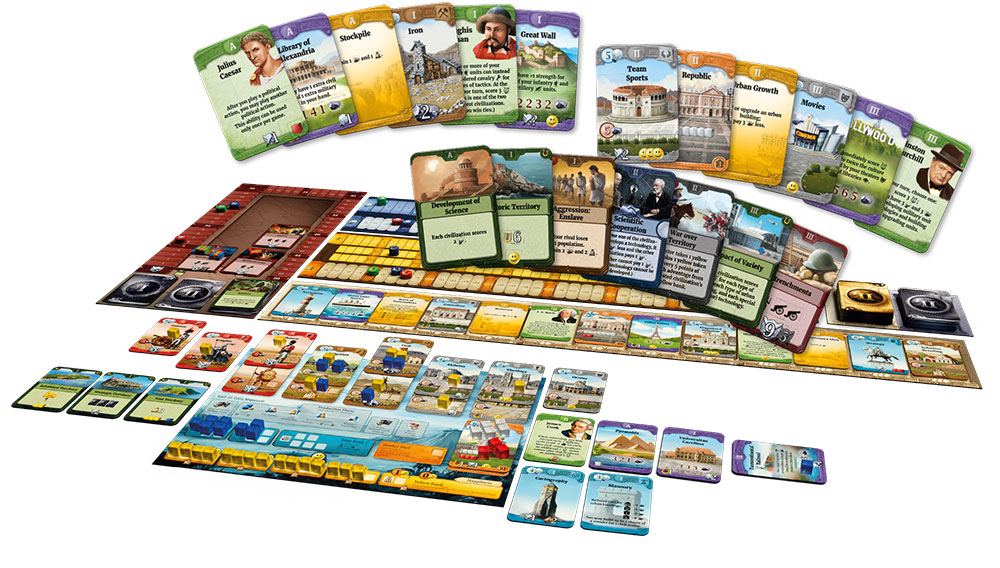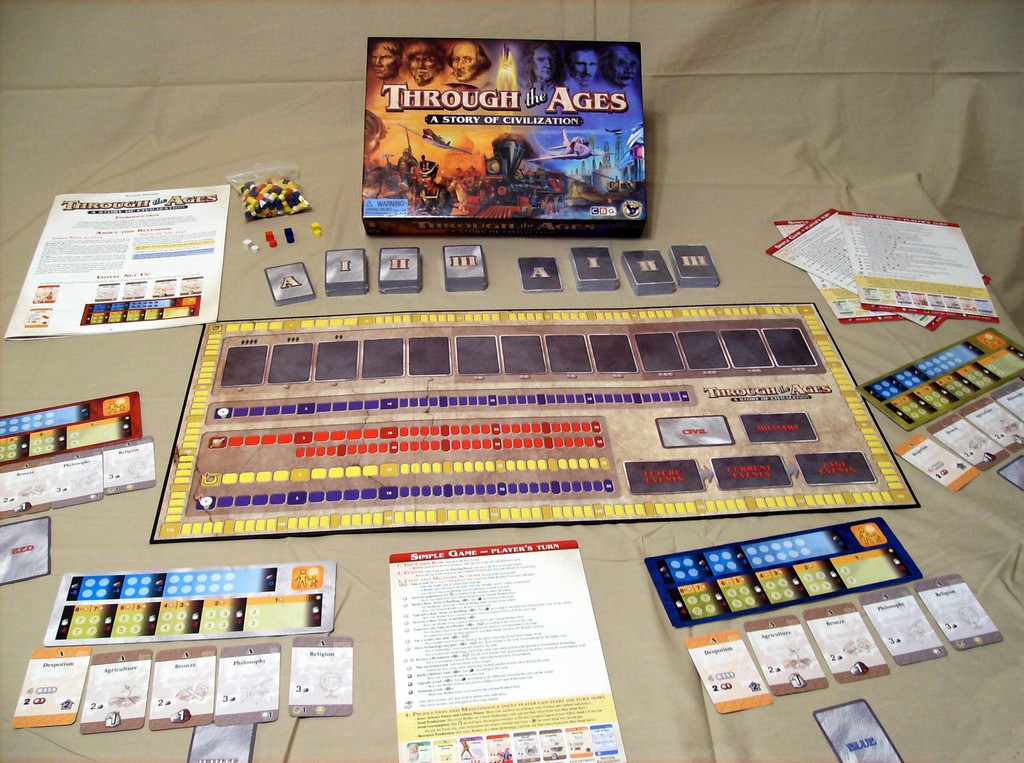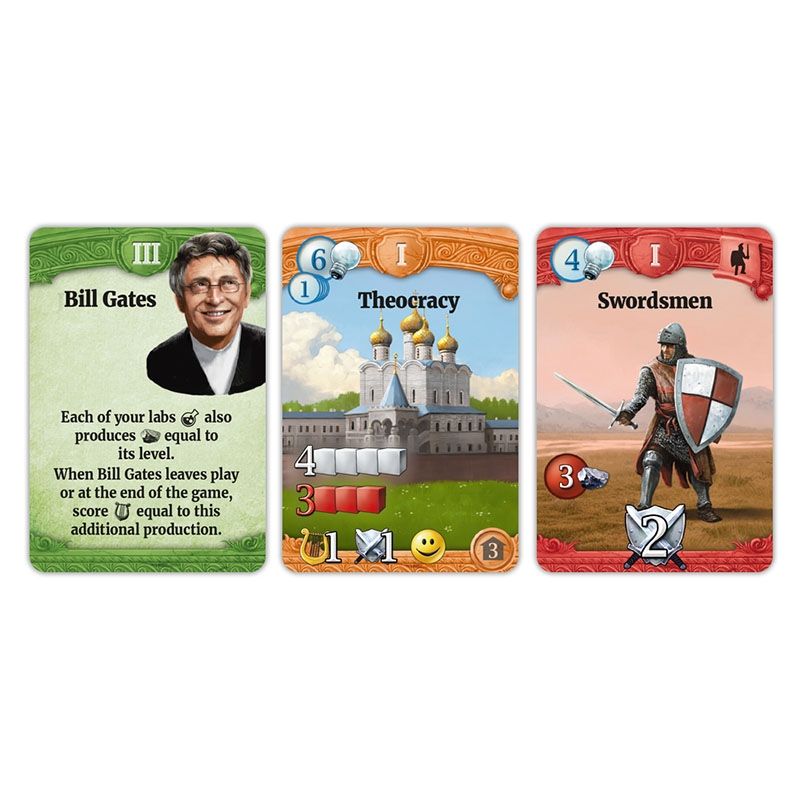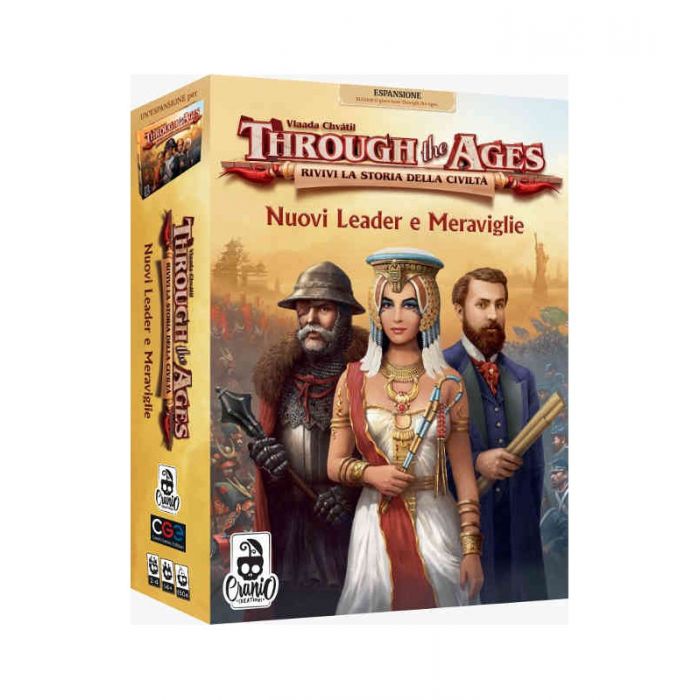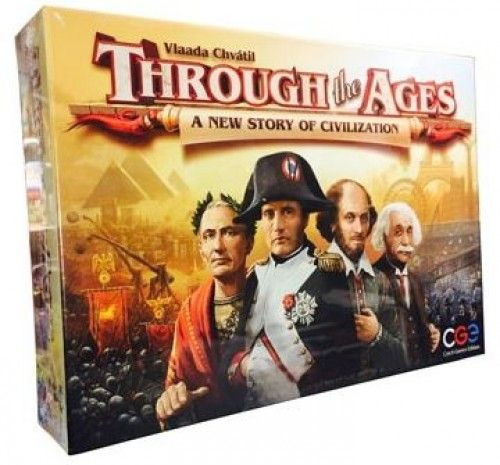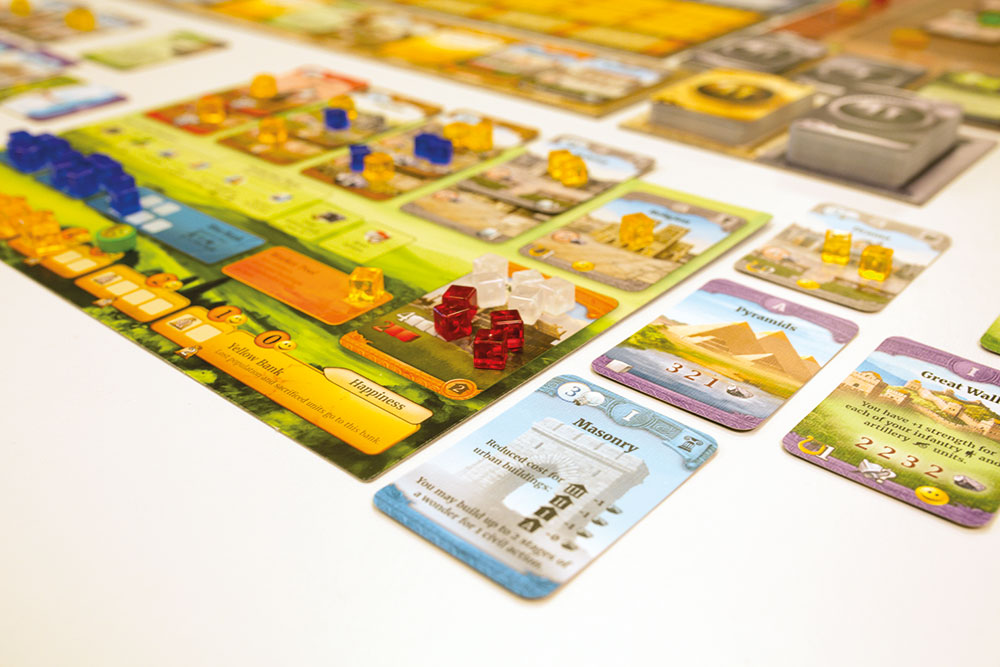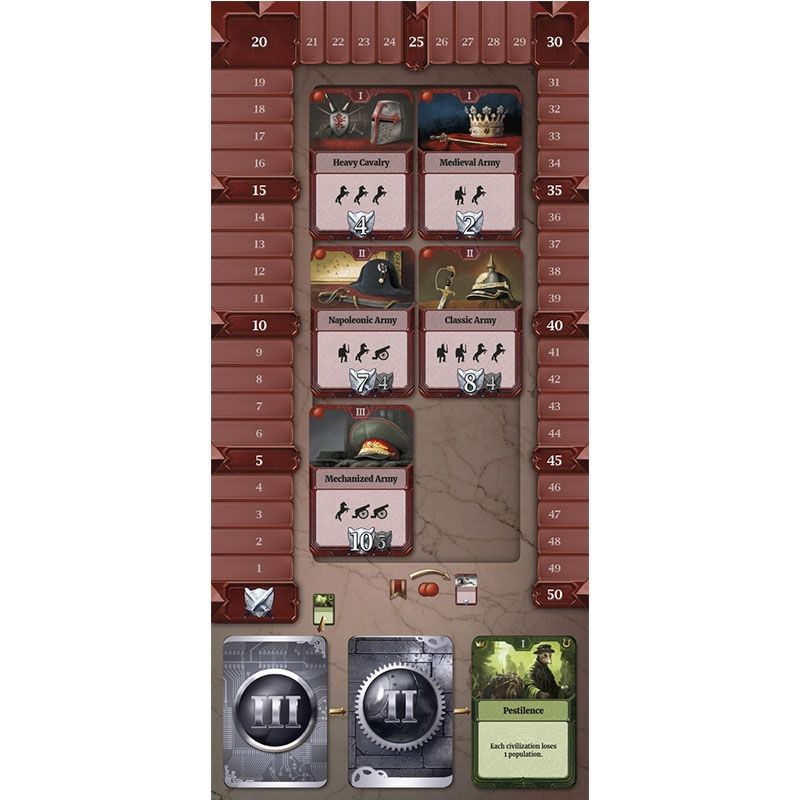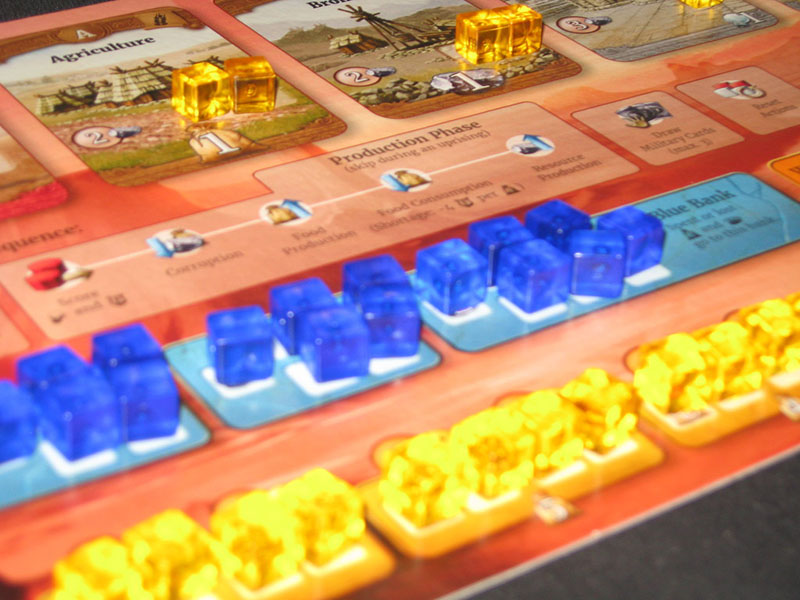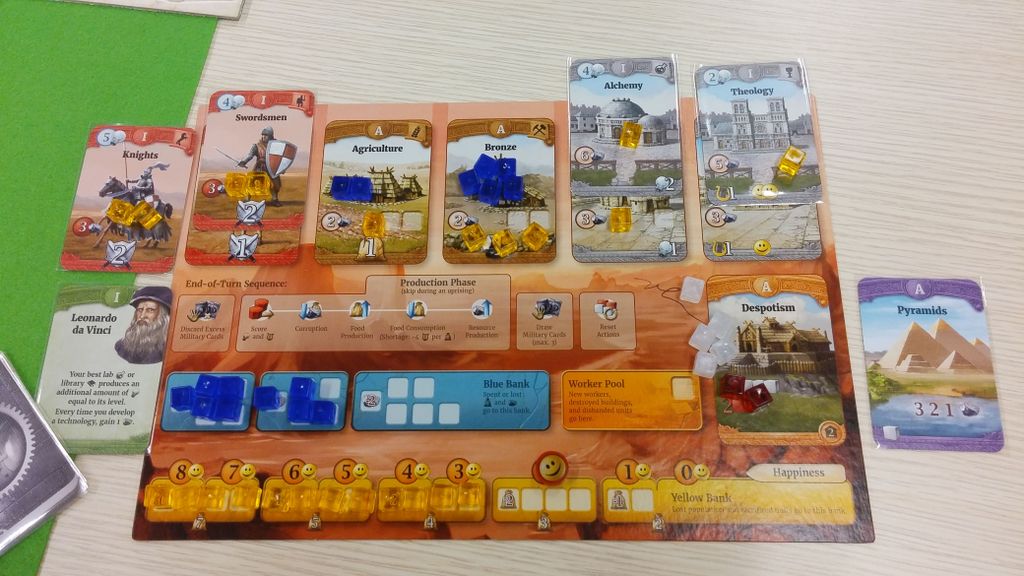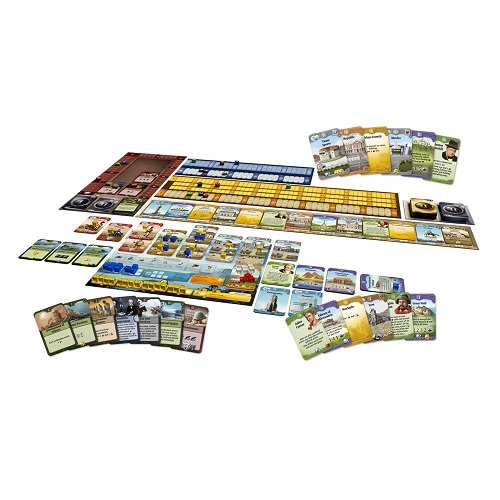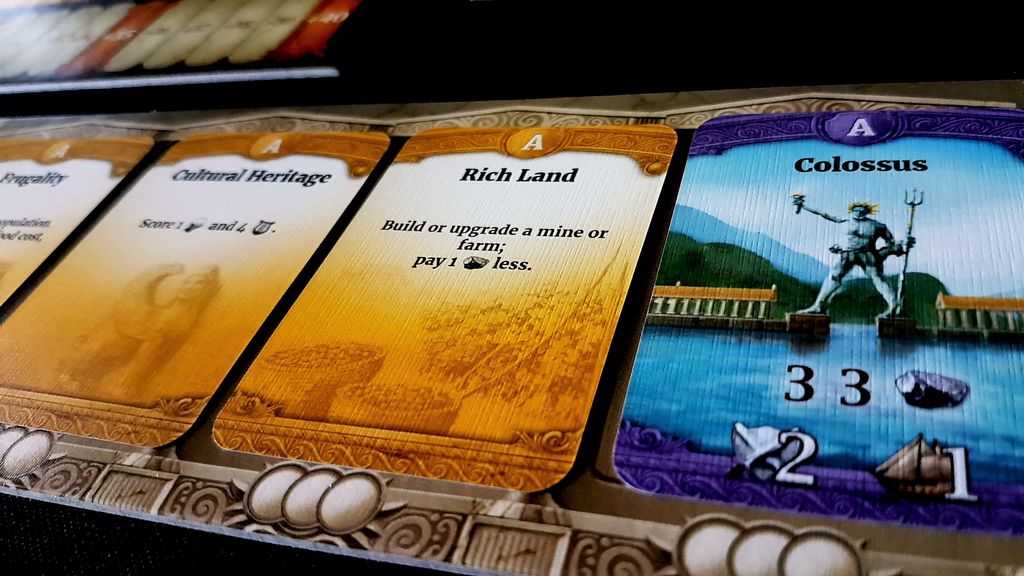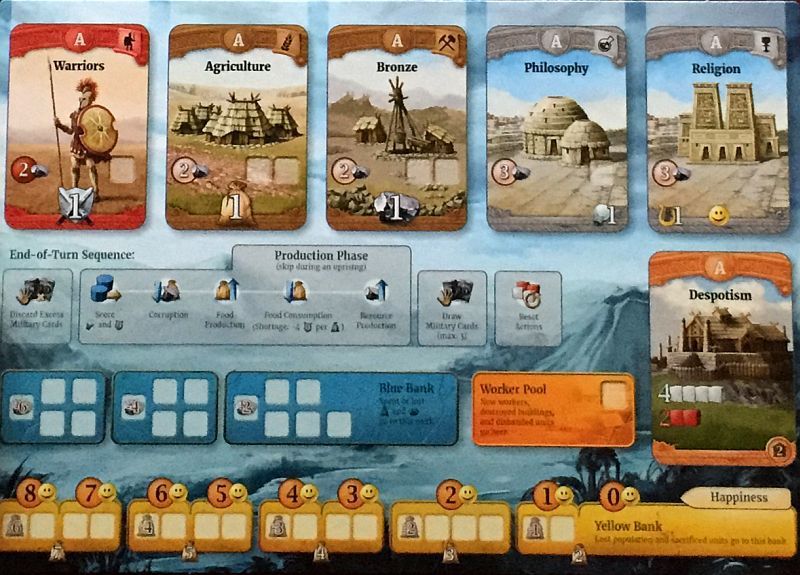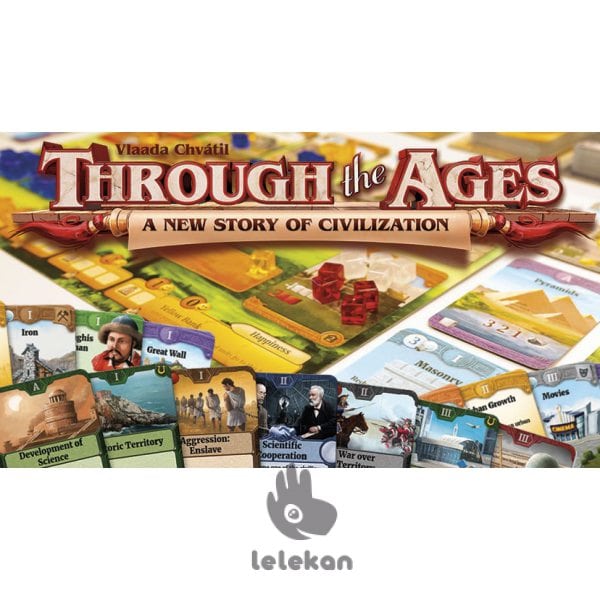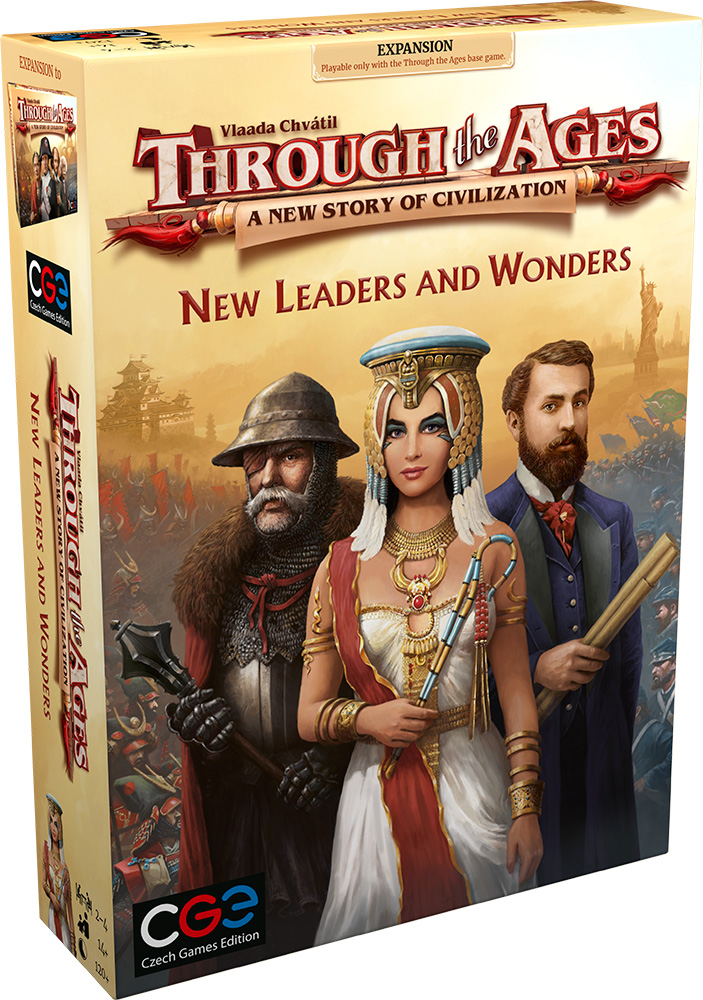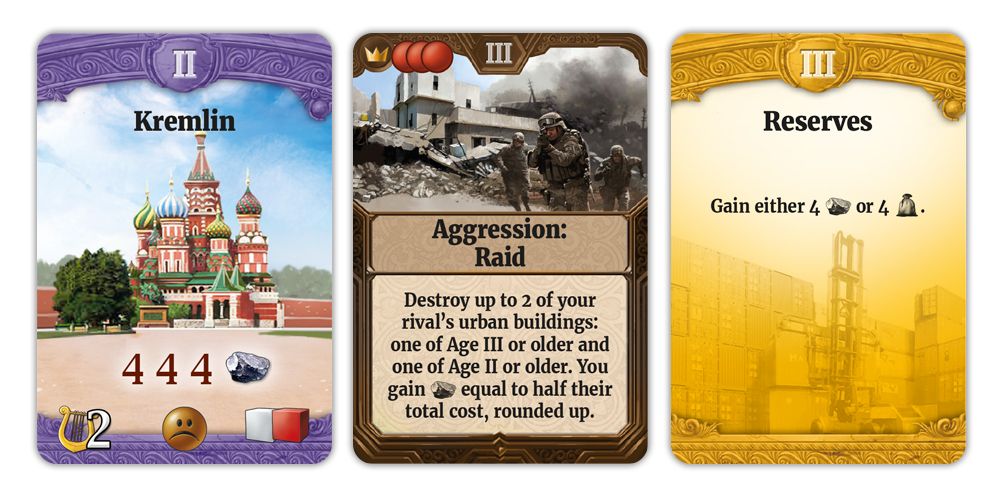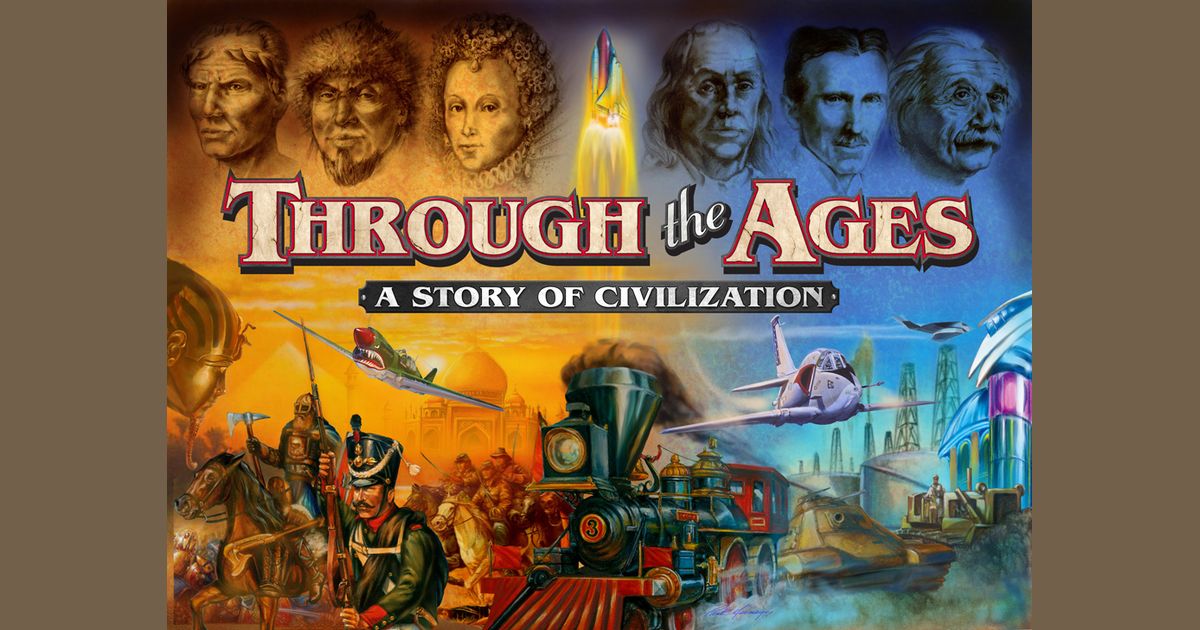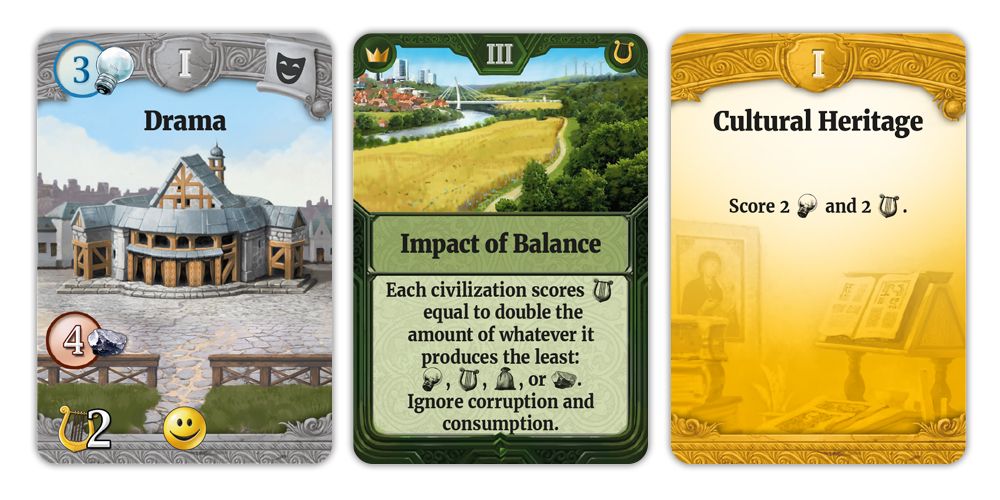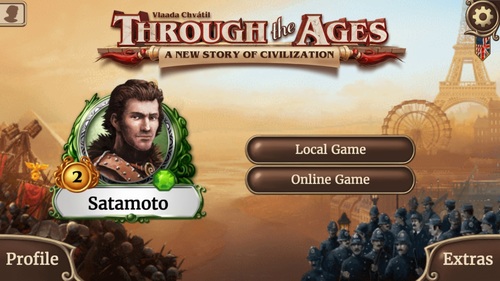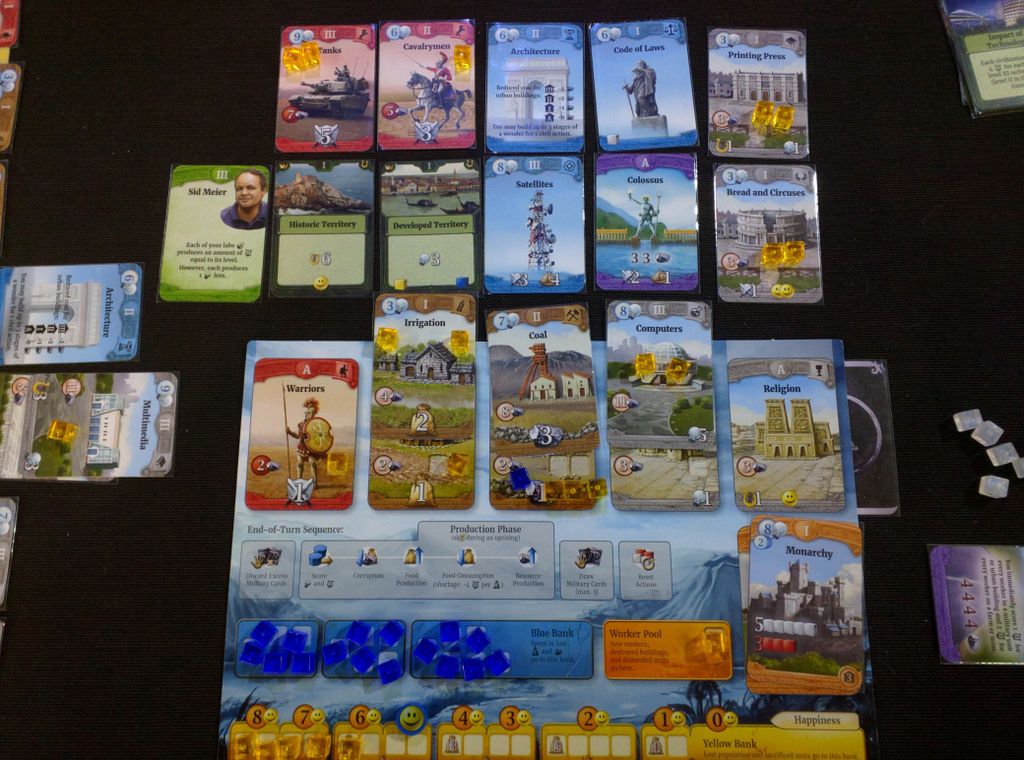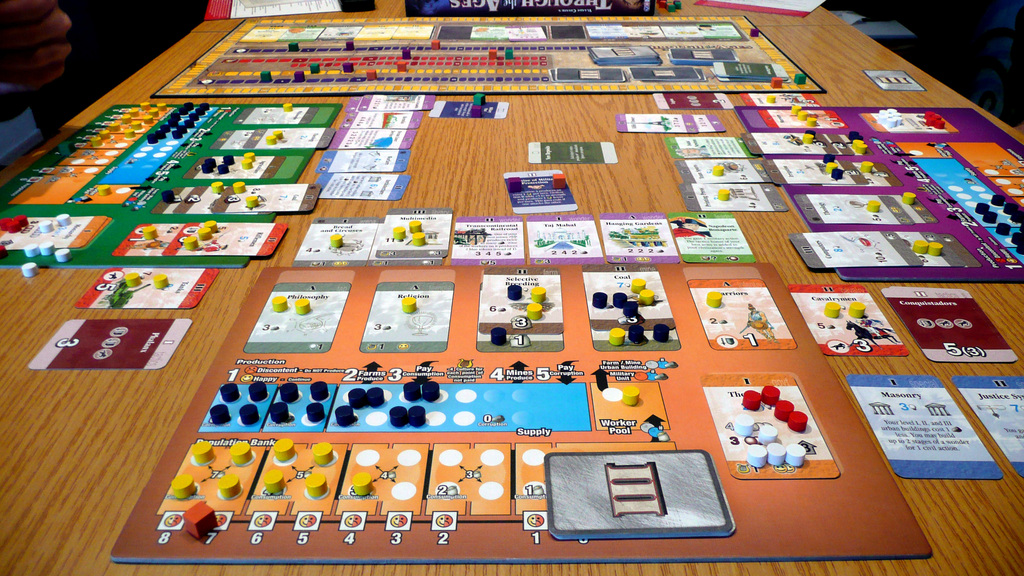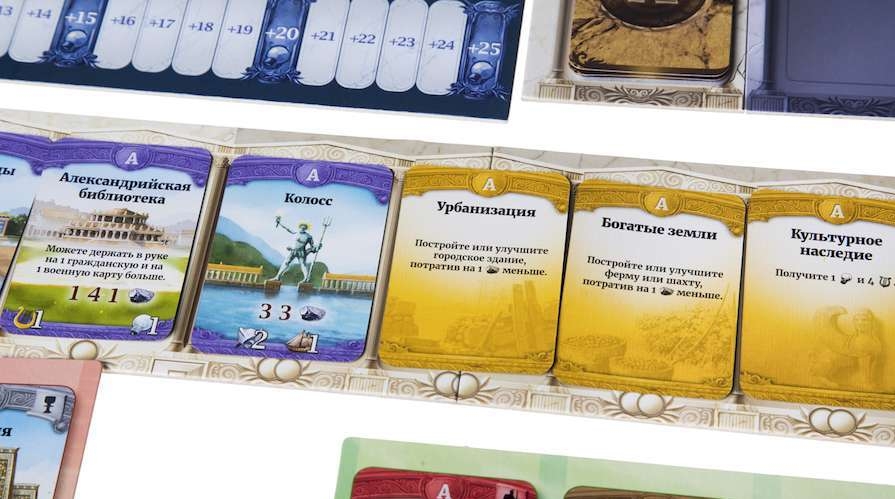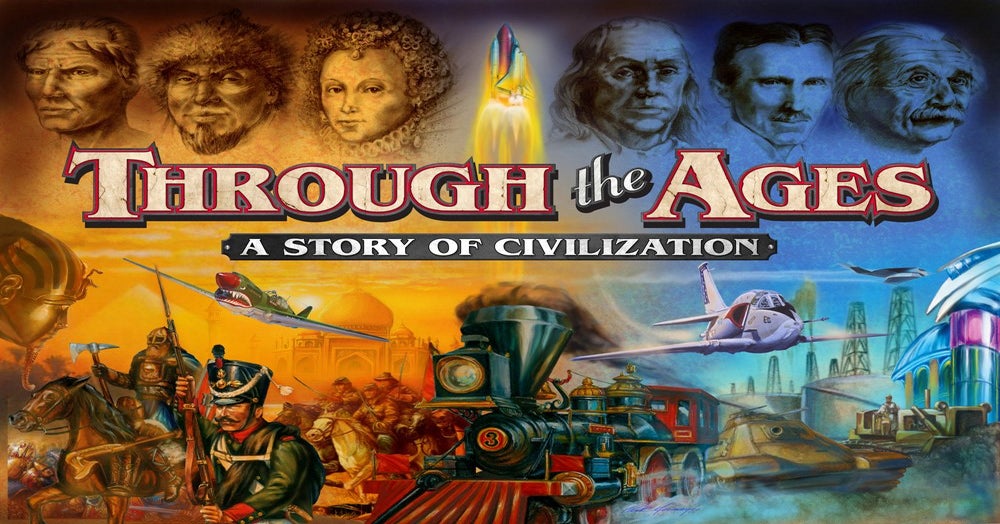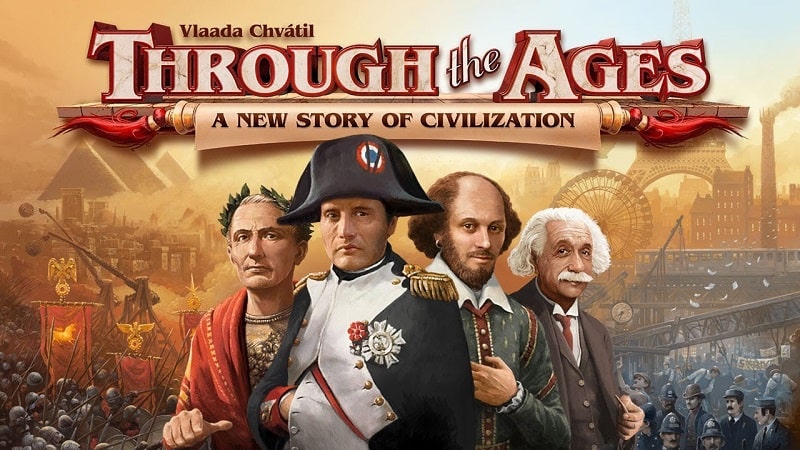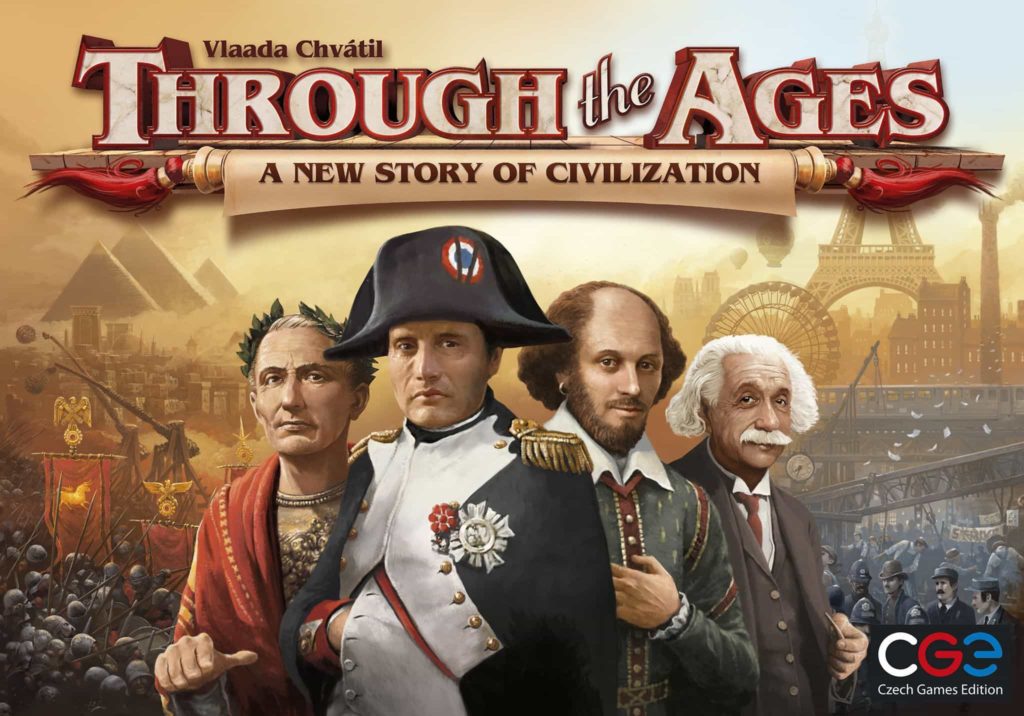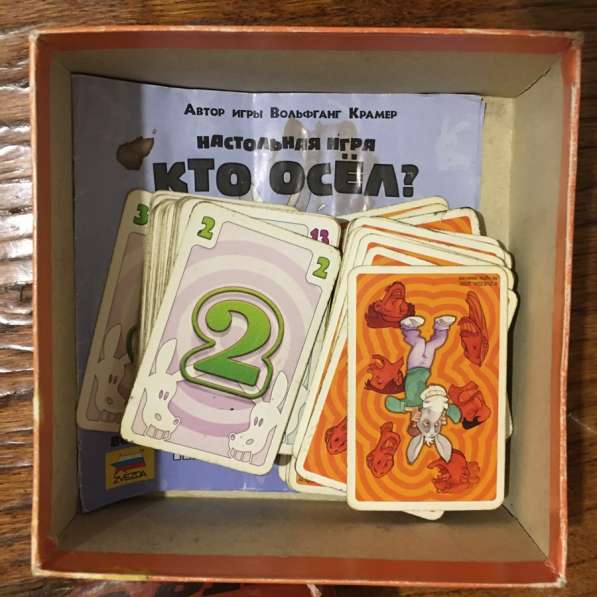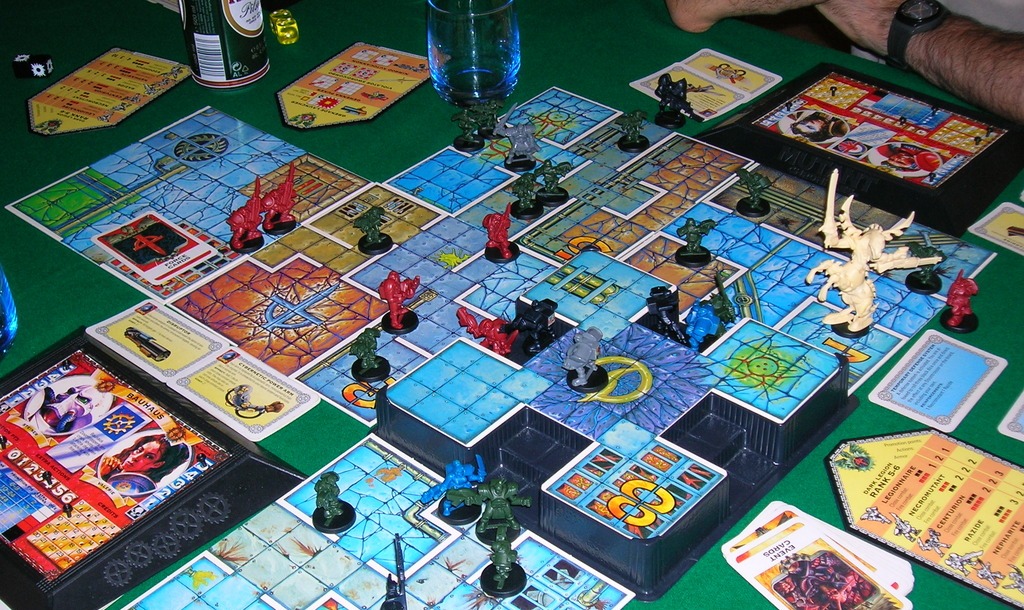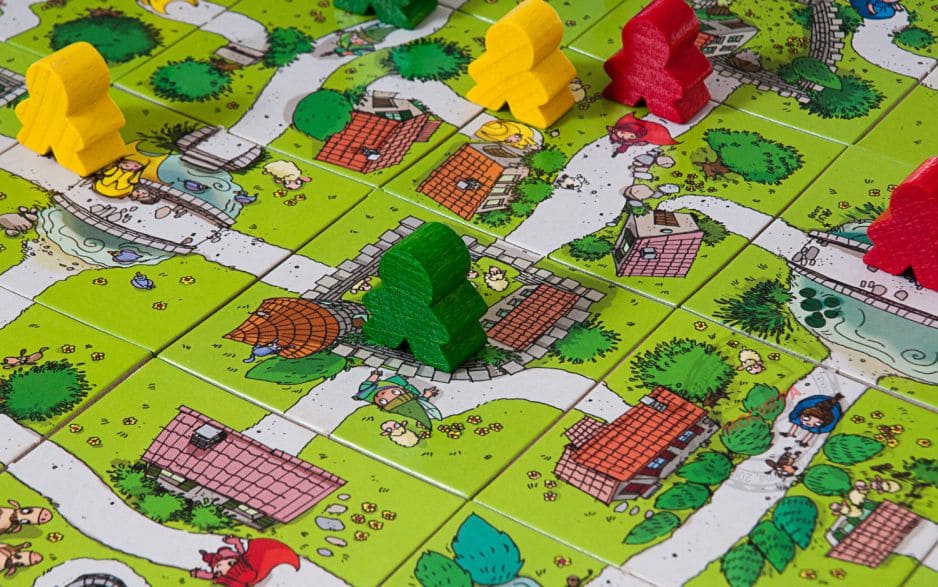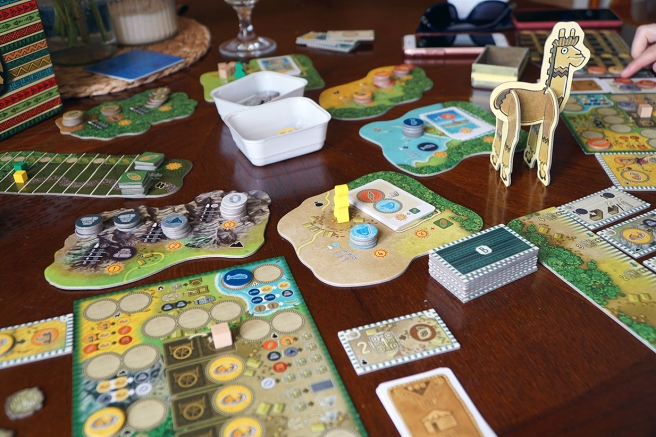Реализация Through the Ages на iPhone и iPad
В Through the Ages на iOS разработчики решили сделать визуальное отображение происходящего на столе. То есть игрок на главном экране 80% времени видит не свои сыгранные карты, а нарисованные постройки.

Количество построек одного типа можно оценить по желтым светящимся точкам. Постройки более высокого уровня строятся над первым уровнем. Апгрейд построек происходит путём переноса жёлтой точки наверх. Количество войск отображается флагами. Чудеса света и колонии виднеются где-то вдали.

К сожалению, в погоне за единообразием iPhone и iPad версий разработчики оставили в верхнем ряду карт только названия. Если на маленьком экране iPhone и даже iPad Mini это как-то оправдано, то на обычном iPad хотелось бы видеть сразу текст на картах и их эффект. Из-за этого кажется, что свободное место используется как-то неэффективно.
В первой партии к этому долго привыкаешь, но буквально со второй проблем с интерфейсом никаких. Ведь в любой момент можно тыкнуть по постройке и узнать как она выглядит в карточном виде. Да и атмосферней как-то получается именно с постройками… Карты в верхнем ряду и в руке тоже можно увеличить, чтобы почитать полное описание.

Интерфейс устроен таким образом, что в любом из этих двух режимов вы можете делать свои действия. Если не помните свойства, то открываете режим карт и делаете на пару кликов больше, если вы – опытный игрок, то карты почти никогда не открываются и это очень удобно.
В цифровом Through the Ages 3 режима игры:
1 – Custom Games – простая игра, которая делится на 2 вида с разными правилами:
- The tabletop rules – правила полностью скопированы с настолки.
- The digital rules – правила немного улучшены для более комфортной игры онлайн. В обычной версии некоторые карты требуют других игроков делать выбор в течение твоего хода. В этих цифровых правилах, если карта события требует от других игроков выбор, то они делают этот выбор во время своего хода после политического действия. Также есть разница в колонизации. В обычных правилах аукцион за карту колонизации происходит на повышение ставок, а в цифровых все делают секретную ставку и выигрывает высшая.
2 – Challenges – набор мини-кампаний, состоящий из 3-4 миссий, которые нужно в рамках одной кампании делать по порядку. Всего 29 миссий: от простой победы над “easy”-оппонентом до сложных вызовов вроде победы над оппонентом, который по умолчанию имеет дополнительную силу +2 и два дополнительных военных действия.

3 – Online – онлайн-игра.
Честно говоря, онлайн-игру я даже не попробовал и сейчас расскажу почему. Искусственный интеллект в Through the Ages играет очень хорошо. Я выигрывал только на лёгком уровне сложности в дуэли. А вот в шести последующих партиях на среднем уровне я потерпел поражение.

Возможно, более опытные игроки будут выносить искусственный интеллект, но за моими плечами всего 6 партий в картонную версию и меня AI разделывает пока под орех…
А зачем играть онлайн, искать более серьёзных противников, если даже Medium AI приносит мне проблемы? Да и кампания из 29 миссий – это серьёзный вызов, чтобы пройти. Учитывая время партии около 40 минут и возрастающую сложность – мне этих челенджей хватит на долгое время.
Видео геймплея:
Вывод: Цифровая Through the Ages получилась отменной. Не без недостатков (их я озвучил в статье), но столь большой и амбициозный проект превзошёл в итоге мои ожидания. Отмечу, что перед нами сложная стратегическая настольная цивилизация для тех, кто любит кризисные настольные игры, где партия на планшете вполне может длиться 40-60 минут. Для продвинутых игроков – Must Try!
Мечта сбылась – Сквозь Века на моём айфончике… Закрою глаза на отсутствие русского, хотя в будущем он бы не помешал. 5 из 5!
P.S. Обзор будет обновляться, ибо у меня теперь новая цифровая любовь…
Tokens
The transparent cubes are blue, yellow, white, and red tokens. You will need a number of these in your play area:
- Take 16 blue tokens and put them on the squares of your blue bank.
- Take 25 yellow tokens and put them on the remaining squares on your player board: 18 in your yellow bank, 1 in your worker pool, and 6 on technologies.
- Take 4 white tokens and 2 red tokens and put them next to the right edge of your player board.
Once everyone has set up their player boards, return the remaining tokens to the box, or keep them somewhere else out of reach. Usually, you will move tokens within your player area. Only rarely do you need to get new tokens from the box or return tokens to the box.
Workers
The seven yellow tokens that are not in your yellow bank are called workers. They represent the initial population of your civilization.
Six of them begin the game on various cards. These workers represent one military unit, two farms, two mines, and one lab..
The seventh worker is in your worker pool. It is called an unused worker. It does nothing useful now, but it is available to be put to work.
Yellow Bank
The yellow tokens in your yellow bank do not represent workers. You may think of them as unused land in your territory.
Whenever your population increases, you take the rightmost yellow token from the yellow bank and put it in your worker pool. You gain a worker, but having fewer tokens in your yellow bank means less available land in your territory. As your population density increases, so do your people’s demands. This is represented by the sections and subsections of your yellow bank.
At the beginning of the game, your people do not consume stored food. They can hunt or grow it for themselves. You use up stored food only when you want your population to grow. The cost of increasing your population is depicted under each section.
As your population grows, the yellow bank empties. You will need some food to maintain your population, and increasing the population will cost you more food.
Farm And Mine Technologies (brown)
Agriculture is a farm technology, which allows you to build farms . Bronze is a mine technology, which allows you to build mines . The card itself does not represent an actual farm or mine. It is just the knowledge required to build them. Farms and mines are represented by your workers on the cards. You start the game with two farms and two mines.
The symbols at the bottom of these technology cards say how much food or resources each farm or mine produces. Food is important for increasing and maintaining your population. Resources are used to build farms, mines, urban buildings, wonders, and military units.
Game Play
Now you are set up for your first game. This is what will happen:
First Round
The game begins in Antiquity, which serves as a preparatory round for the rest of the game. In the first round, players have just a few civil actions. They take cards from the card row to shape the way their civilizations will initially grow. Each player’s turn ends with production of science, food, and resources.
Read here all detailed information about the first round.
Second Round
From the second round on, a few new civil cards appear in the card row at the beginning of each player’s turn. The Middle Ages begin in the second round, and Age I cards appear in the card row.
On their second turn, players may begin building and developing their civilizations. They may use all their civil and military actions, and they may do more than just take cards. They will also have an opportunity to draw military cards after production.
Read here all detailed information about the second round.
Subsequent Rounds
From the third round on, players will have military cards. These allow players to plot political maneuvers and improve their military forces with tactics. Of course, players continue to work on increasing their population, developing new technologies, and expanding their production of food, resources, science, and culture. They will take steps to ensure their people remain happy, and they may also need to deal with corruption.
Read here all detailed information about the subsequent rounds.
When the Age I civil cards run out, Age II, the Age of Exploration, begins. Certain antiquated cards are discarded, and populations become more demanding, but otherwise, the game continues under the same rules. Age II civil and military cards enter the game, bringing advanced technologies, industrial wonders, and enlightened leaders.
The End
Your first game is shortened. When the Age II civil deck runs out, the game is near its end. Again, certain antiquated cards are discarded and the demands of your population increase. Age III, The Modern Era, begins, but you do not use Age III cards.
Each player is granted at least one more turn to put the finishing touches on a glorious civilization. The player to the right of the starting player will take the final turn, so that everyone will finish with the same number of turns. The player with the most culture points wins.
Urban Building Technologies (gray)
Philosophy allows you to build labs and Religion allows you to build temples . As with farms and mines, actual buildings are represented by workers on the cards. The card itself just means you know how to build them. At the beginning of the game, you have 1 lab, but you have no temples yet – there is no worker on the Religion card.
The icons at the bottom of each urban building technology depict what is produced by each building on the card. Your one lab produces a total of 1 science . Your temples would produce 1 culture and 1 happy face each, but you have no temples yet.
The icon in the upper right corner (, ) defines the type of the card and the type of the buildings that are on it. Later, you may invent more advanced labs and temples or even completely new types of buildings.
Ages and Levels
The A symbol at the top of each initial technology means that these cards belong to Age A – Antiquity. Any card in the game belongs to one of four ages:
- Age A: Antiquity (BC and the first few centuries AD)
- Age I: Medieval Times (up to the 16th century)
- Age II: The Age of Exploration (up to the 19th century)
- Age III: The Modern Era (the 20th century)
In your first game, you will not use Age III cards. The game will end when you reach the Modern Era.
Sometimes, the rules or a card will refer to the level of a card. This is simply the card’s age represented as a number: Cards of Age A have level 0. Age I is level 1. Age II is level 2. Age III is level 3.
The level or age of a farm, mine, urban building, or military unit is the same as the level or age of the card that it is on.
Government (orange)
The orange card represents your civilization’s system of government. It specifies the number of civil actions and military actions available each turn. These actions represent the effectiveness of your government. They determine how many different things you can do.
Every civilization begins with Despotism. The 4 white cubes and 2 red cubes printed on the card indicate that you have 4 civil actions and 2 military actions at your disposal. These are represented by the white and red tokens you have next to your board.
Later, you may switch to a more advanced form of government, which will give you more civil and military actions.
Happiness Indicator
Various urban buildings, wonders, and leaders provide happy faces – a symbolic representation of things that keep your people happy, such as art, religion, or entertainment.
Your total number of happy faces is indicated by your happiness marker above your yellow bank. At the beginning of the game, the only technology that provides happy faces is Religion. Because you have no workers on that card, you have no temples , so your happiness rating marker begins on space 0.
Continue Reading
report this ad
Setup
Player Areas
In Through the Ages, there is no map. You build your civilization on the table in the space in front of you. This space is called your player area.
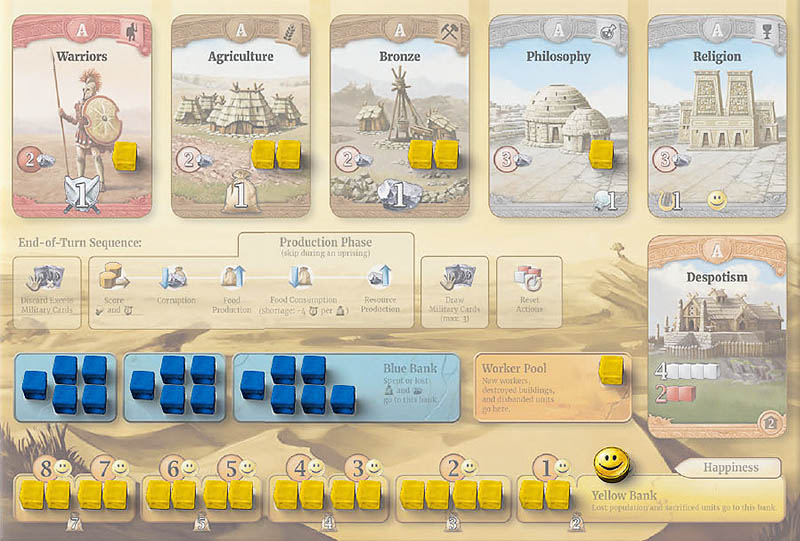
Read here all detailed information about the player areas.
Common Areas
Set up the game boards in the center of the table in any configuration that makes it easy for everyone to see them.
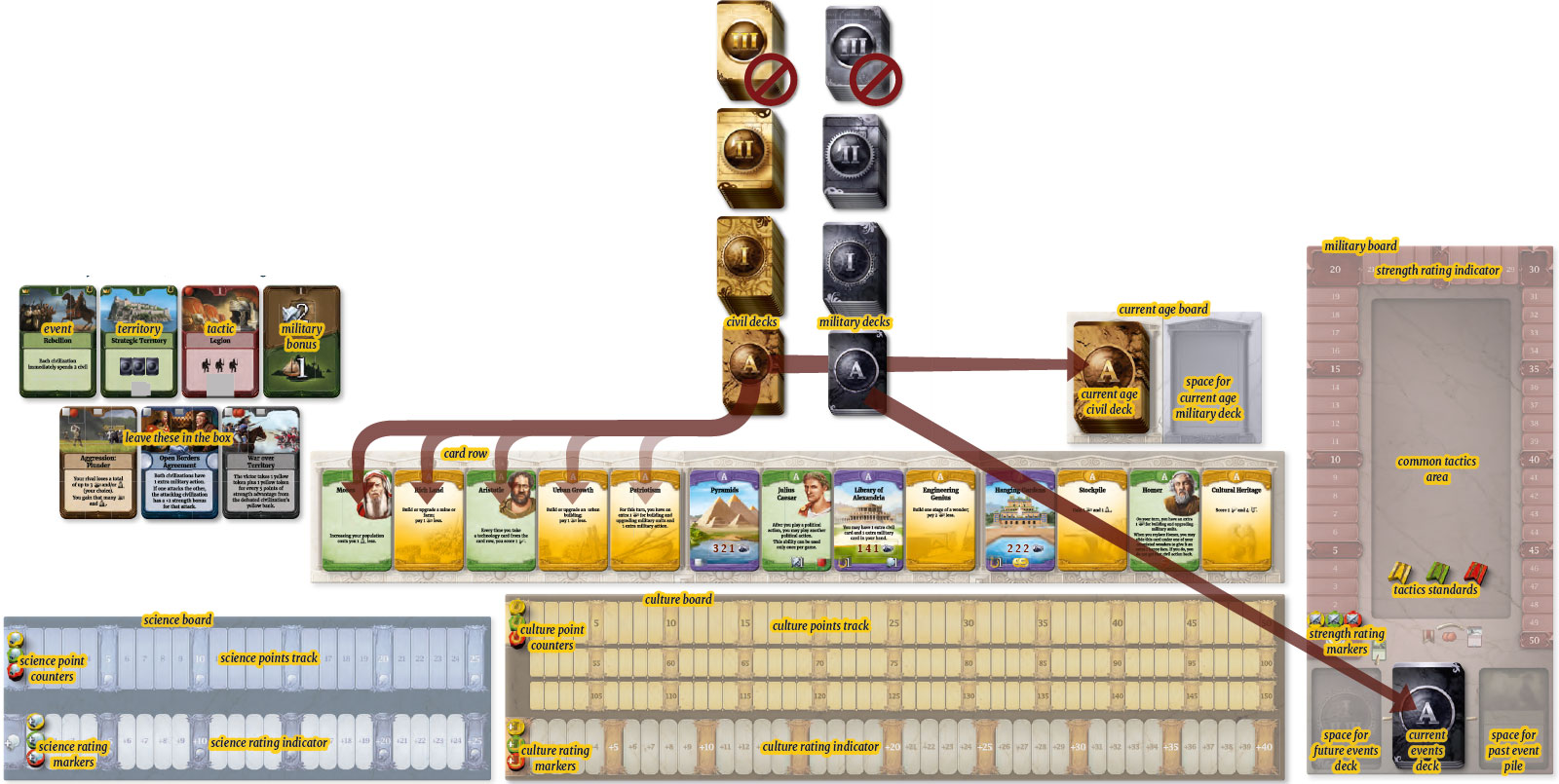
Read here all detailed information about the common areas.
Starting Player
Randomly determine the starting player. The starting player does not change during the game and has no special role. However, to ensure that everyone gets the same number of turns, it is important to remember who the starting player was.
If you like, you can mark the starting player by sliding one of the unused Age A military cards partially under that player’s board.
Blue Bank
Blue tokens represent food and resources. On a farm technology, they are food. On a mine technology, they are resources. You keep the blue tokens in your blue bank until they are needed.
When your workers produce food and resources, you move blue tokens from your blue bank to the cards. Always move the rightmost tokens first.
When you use the food and resources, you return the tokens to your blue bank. Fill empty spaces from left to right.
If a section of your blue bank is empty, it means your civilization is storing a lot of food and resources. This is not a problem if you spend them during your turn, but if you still have empty sections at the end of your turn, you will face corruption.
Суть Сквозь Века, или Как захватить мир?!
Начну с того, что правила Through the Ages даже в кратком изложении объяснять – бесполезное занятие. Игра комплексная и правил с нюансами там очень много. Попробую пояснить суть.
В Through the Ages игроки переживают 4 эпохи. Главная цель – набрать как можно больше очков культуры. Делается это за счёт розыгрыша карт и дальнейшего взаимодействия с ними. Каждый ход происходит примерно следующее:
Фаза политики – игрок может добавить карту в колоду политики, но при этом разыгрывается какое-то событие из неё. Это могут быть как бонусы для вашей цивилизации, так и какие-то штрафы… Также могут выпасть колонии, за которые игроки соревнуются в аукционе. Также игрок может совершить агрессию против соперника или объявить войну, которая разрешится после хода всех игроков.
Фаза действий – игрок тратит все свои очки действий на них. Вариантов много, можно:
- купить карты из открытого ряда
- разыграть карту с руки
- исследовать новую технологию
- построить шахту, здание, нанять воинов
- улучшить шахту, здание, воинов
- нанять новых работников
- провести революцию
и тому подобное. После этого идёт прирост ресурсов, проверка на недовольство населения… Ход переходит к следующему игроку.
Собственно, вся механика строится на грамотном использовании своих действий и карт. Вы постоянно будете испытывать недостаток в чём-то. Through the Ages – очень кризисная настолка. Если удариться в науку, то можно просесть по войне, если строить много воинов, то можно испытывать дефицит ресурсов и науки. Причём кризис наступит обязательно в одной из сфер и лёгкой прогулки не будет.
В цифровом Through the Ages хорошо решили проблему объёмных правил. В приложение встроен интерактивный Tutorial, который очень чётко и с юмором рассказывает все принципы игры.

Но тут возникает минус – игра на английском языке. Поэтому, если у вас с ним проблемы, то поиграть попросту не удастся. Текста хватает: помимо обучения на языке Шекспира в игре есть карты со свойствами, лог, который в словесной форме отображает все ходы, пояснения к челенджам и т.п.

Перевод Through the Ages на любой язык – трудоёмкая задача и далеко не факт, что этот перевод окупился бы разработчикам даже за 2 года…
Through the Ages (Русская версия)
«Through the Ages» – это официальная адаптация классической стратегии Владада Хватила, третьей по популярности настольной игры в истории по версии сайта Board Game Geek. Это ваш шанс сделать историю – вы начинаете с небольшого племени, и, расширяя свои фермы и шахты, вы закладываете основу для технического прогресса, улучшения правительств и великих чудес. Ваша военная мощь может поддержать ваши политические навыки в пути к величию вашей цивилизации. Дополнение New Leaders & Wonders добавляет захватывающий новый контент в базовую игру, добавляя лидеров, чудеса и военные карты, чтобы вы могли изменить ход истории и построить еще большие цивилизации.Through the Ages – это одна из лучших адаптаций известной настольной стратегии, игра, в которой вам придется превратить маленькое племя в настоящее государство, а заодно стать самым настоящим правителем. И первым делом стоило бы сказать о том, что начнете вы с самого малого, а именно, с небольшого племени, которое вам придется развивать всеми возможными способами
В самом начале в вашем распоряжении будет очень мало ресурсов, как человеческих, так и остальных, но уже через некоторое время ваше будущее государство начнет расти, в нем прибавится жителей, ресурсов станет больше, и что не менее важно, оно обзаведется собственными границами. ну а дальше все как по накатанной.В Through the Ages вам придется строить собственную государственность, развивать поселение, добывать ресурсы
расширять владения, строить шахты и производства, создавать все необходимые условия для того, чтоб жителям ваших владений было хорошо. Причем, следить вам придется не только за тем, чтоб хватало ресурсов и денег, но и за тем, чтоб правительство давало людям то, в чем они нуждаются, и не только. Но стоит сказать и о том, что в основе всего тут лежит продуманная карточная система управления. В вашем распоряжении будет огромное количество карт, и каждая карта сыграет важную роль в вашем развитии. Одна может позволить вам открыть чудо света или расширить собственные владения, другая даст вам возможность изменить что-то в политике правительства, а третья и вовсе даст вам невиданный ранее бонус. Вариантов достаточно много. А еще вас ждет огромное количество возможностей в плане менеджмента. Вы будете управлять буквально всеми аспектами жизни государства, и только вы будете в ответе за то, что будет происходить с ним далее. Развивайтесь, стройте политику в отношении конкурентов, добывайте ресурсы, налаживайте экономику, создайте мощную армию и сделайте все возможное для того, чтоб стать по-настоящему великим правителем.Ключевые особенности игры Through the Ages (Русская версия):- Изучите правила игры с забавным и интересным обучением.- Побеждайте умных компьютерных противников различного уровня мастерства.- Играйте с оригинальными правилами настольной игры или упрощенной цифровой версией.- Интересные задания, требующие разных подходов для их выполнения.Дополнения к игреThrough the Ages (Русская версия):- New Leaders & WondersМинимальные системные требования игры Through the Ages (Русская версия):- Операционная система: Windows 7 / 8 / 10- Процессор: 2 GHz processor single core- Память: 2 GB RAM- Графика: Intel HD Graphics 3000- Хранение: 250 MB
Жанр: Карты / СтратегияЯзык интерфейса: Русский / Multi 14Инсталлятор. Версия игры: 2.11.47Размер: 126 МбСкачать с Облака:
Жанр: Карточные / Пасьянсы / Стратегии / Башенки
+28
E. End of the Game
The game ends when the last player (the player to the right of the starting player) finishes his or her last turn. Then it is time for final scoring.
Final Scoring
At the end of your first game, each player scores extra culture points for civilization achievements:
- Score 1 culture for each of your Age I technologies and 2 culture for each of your Age II technologies. Your government counts twice.
- Score culture equal to your science rating.
- Score culture equal to your strength rating.
- Score culture equal to your happiness rating.
- Score culture equal to your food and resource production. (Count up how much food and resources your workers produce during your production phase. Ignore corruption and consumption).
- Score 3 culture for each of your colonies.
- Score 6 culture for each of your completed Age II wonders.
Go through the scoring list step by step, giving each player a chance to count up the corresponding number of points.
Note: This list applies only to your first game. The full game has a different end- of-game scoring system.
The Winner
The player with the most culture points wins. In case of a tie, all tied players share the victory.
But what’s most important is that you finished your first game of Through the Ages. Next time, you will be ready to play the full game:
Continue Reading


